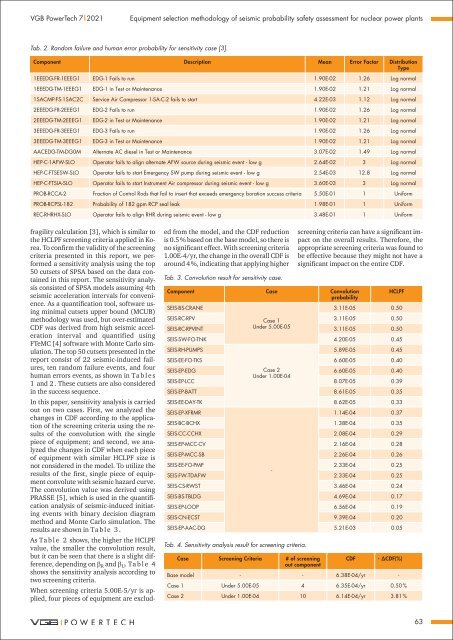VGB POWERTECH 7 (2021) - International Journal for Generation and Storage of Electricity and Heat
VGB PowerTech - International Journal for Generation and Storage of Electricity and Heat. Issue 7 (2021). Technical Journal of the VGB PowerTech Association. Energy is us! Optimisation of power plants. Thermal waste utilisation.
VGB PowerTech - International Journal for Generation and Storage of Electricity and Heat. Issue 7 (2021).
Technical Journal of the VGB PowerTech Association. Energy is us!
Optimisation of power plants. Thermal waste utilisation.
- No tags were found...
You also want an ePaper? Increase the reach of your titles
YUMPU automatically turns print PDFs into web optimized ePapers that Google loves.
<strong>VGB</strong> PowerTech 7 l <strong>2021</strong><br />
Equipment selection methodology <strong>of</strong> seismic probability safety assessment <strong>for</strong> nuclear power plants<br />
Tab. 2. R<strong>and</strong>om failure <strong>and</strong> human error probability <strong>for</strong> sensitivity case [3].<br />
Component Description Mean Error Factor Distribution<br />
Type<br />
1EEEDG-FR-1EEEG1 EDG-1 Fails to run 1.90E-02 1.26 Log normal<br />
1EEEDG-TM-1EEEG1 EDG-1 in Test or Maintenance 1.90E-02 1.21 Log normal<br />
1SACMP-FS-1SAC2C Service Air Compressor 1-SA-C-2 fails to start 4.22E-03 1.12 Log normal<br />
2EEEDG-FR-2EEEG1 EDG-2 Fails to run 1.90E-02 1.26 Log normal<br />
2EEEDG-TM-2EEEG1 EDG-2 in Test or Maintenance 1.90E-02 1.21 Log normal<br />
3EEEDG-FR-3EEEG1 EDG-3 Fails to run 1.90E-02 1.26 Log normal<br />
3EEEDG-TM-3EEEG1 EDG-3 in Test or Maintenance 1.90E-02 1.21 Log normal<br />
AACEDG-TM-DG0M Alternate AC diesel in Test or Maintenance 3.07E-02 1.49 Log normal<br />
HEP-C-1AFW-SLO Operator fails to align alternate AFW source during seismic event - low g 2.64E-02 3 Log normal<br />
HEP-C-FTSESW-SLO Operator fails to start Emergency SW pump during seismic event - low g 2.54E-03 12.8 Log normal<br />
HEP-C-FTSIA-SLO Operator fails to start Instrument Air compressor during seismic event - low g 3.60E-03 3 Log normal<br />
PROB-RCCA-2 Fraction <strong>of</strong> Control Rods that fail to insert that exceeds emergency boration success criteria 5.50E-01 1 Uni<strong>for</strong>m<br />
PROB-RCPSL-182 Probability <strong>of</strong> 182 gpm RCP seal leak 1.98E-01 1 Uni<strong>for</strong>m<br />
REC-RHRHX-SLO Operator fails to align RHR during seismic event - low g 3.48E-01 1 Uni<strong>for</strong>m<br />
fragility calculation [3], which is similar to<br />
the HCLPF screening criteria applied in Korea.<br />
To confirm the validity <strong>of</strong> the screening<br />
criteria presented in this report, we per<strong>for</strong>med<br />
a sensitivity analysis using the top<br />
50 cutsets <strong>of</strong> SPSA based on the data contained<br />
in this report. The sensitivity analysis<br />
consisted <strong>of</strong> SPSA models assuming 4th<br />
seismic acceleration intervals <strong>for</strong> convenience.<br />
As a quantification tool, s<strong>of</strong>tware using<br />
minimal cutsets upper bound (MCUB)<br />
methodology was used, but over-estimated<br />
CDF was derived from high seismic acceleration<br />
interval <strong>and</strong> quantified using<br />
FTeMC [4] s<strong>of</strong>tware with Monte Carlo simulation.<br />
The top 50 cutsets presented in the<br />
report consist <strong>of</strong> 22 seismic-induced failures,<br />
ten r<strong>and</strong>om failure events, <strong>and</strong> four<br />
human errors events, as shown in Ta b l e s<br />
1 <strong>and</strong> 2 . These cutsets are also considered<br />
in the success sequence.<br />
In this paper, sensitivity analysis is carried<br />
out on two cases. First, we analyzed the<br />
changes in CDF according to the application<br />
<strong>of</strong> the screening criteria using the results<br />
<strong>of</strong> the convolution with the single<br />
piece <strong>of</strong> equipment; <strong>and</strong> second, we analyzed<br />
the changes in CDF when each piece<br />
<strong>of</strong> equipment with similar HCLPF size is<br />
not considered in the model. To utilize the<br />
results <strong>of</strong> the first, single piece <strong>of</strong> equipment<br />
convolute with seismic hazard curve.<br />
The convolution value was derived using<br />
PRASSE [5], which is used in the quantification<br />
analysis <strong>of</strong> seismic-induced initiating<br />
events with binary decision diagram<br />
method <strong>and</strong> Monte Carlo simulation. The<br />
results are shown in Ta b l e 3 .<br />
As Ta b l e 2 shows, the higher the HCLPF<br />
value, the smaller the convolution result,<br />
but it can be seen that there is a slight difference,<br />
depending on β R <strong>and</strong> β U . Table 4<br />
shows the sensitivity analysis according to<br />
two screening criteria.<br />
When screening criteria 5.00E-5/yr is applied,<br />
four pieces <strong>of</strong> equipment are excluded<br />
from the model, <strong>and</strong> the CDF reduction<br />
is 0.5 % based on the base model, so there is<br />
no significant effect. With screening criteria<br />
1.00E-4/yr, the change in the overall CDF is<br />
around 4 %, indicating that applying higher<br />
Tab. 3. Convolution result <strong>for</strong> sensitivity case.<br />
Component Case Convolution<br />
probability<br />
SEIS-BS-CRANE<br />
screening criteria can have a significant impact<br />
on the overall results. There<strong>for</strong>e, the<br />
appropriate screening criteria was found to<br />
be effective because they might not have a<br />
significant impact on the entire CDF.<br />
HCLPF<br />
3.11E-05 0.50<br />
SEIS-RC-RPV<br />
Case 1<br />
3.11E-05 0.50<br />
SEIS-RC-RPVINT<br />
Under 5.00E-05<br />
3.11E-05 0.50<br />
SEIS-SW-FO-TNK 4.20E-05 0.45<br />
SEIS-RH-PUMPS<br />
5.89E-05 0.45<br />
SEIS-EE-FO-TKS 6.60E-05 0.40<br />
SEIS-EP-EDG Case 2<br />
6.60E-05 0.40<br />
Under 1.00E-04<br />
SEIS-EP-LCC 8.07E-05 0.39<br />
SEIS-EP-BATT 8.61E-05 0.35<br />
SEIS-EE-DAY-TK 8.62E-05 0.33<br />
SEIS-EP-XFRMR<br />
1.14E-04 0.37<br />
SEIS-BC-BCHX 1.38E-04 0.35<br />
SEIS-CC-CCHX 2.08E-04 0.29<br />
SEIS-EP-MCC-CV 2.16E-04 0.28<br />
SEIS-EP-MCC-SB 2.26E-04 0.26<br />
SEIS-EE-FO-PMP 2.33E-04 0.25<br />
-<br />
SEIS-FW-TDAFW 2.33E-04 0.25<br />
SEIS-CS-RWST 3.46E-04 0.24<br />
SEIS-BS-TBLDG 4.69E-04 0.17<br />
SEIS-EP-LOOP 6.56E-04 0.19<br />
SEIS-CN-ECST 9.39E-04 0.20<br />
SEIS-EP-AAC-DG 5.21E-03 0.05<br />
Tab. 4. Sensitivity analysis result <strong>for</strong> screening criteria.<br />
Case Screening Criteria # <strong>of</strong> screening<br />
out component<br />
CDF<br />
- ΔCDF(%)<br />
Base model - - 6.38E-04/yr -<br />
Case 1 Under 5.00E-05 4 6.35E-04/yr 0.50 %<br />
Case 2 Under 1.00E-04 10 6.14E-04/yr 3.81 %<br />
63


















